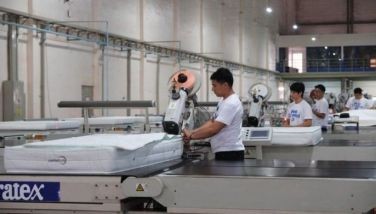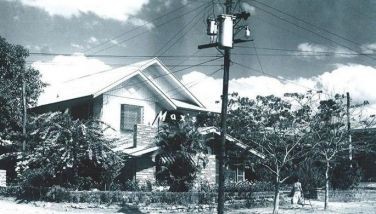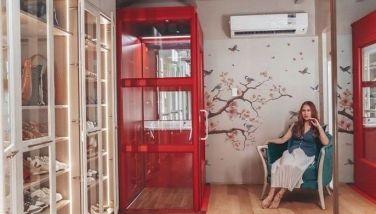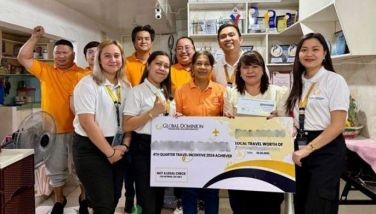Home for wayward youth

May 3, 2005 | 12:00am
Children, by virtue of poverty, end up committing crimes. They should not, however, be lumped with hardened adult criminals in dingy prison cells. While they are awaiting court sentences, these minors should be housed in specially-designed detention centers where they are given opportunities for treatment, rehabilitation, wholesome reunions with their families, and integration in their communities.
That ideal situation for youthful offenders has been mandated by Presidential Decree No. 603, also known as the Child and Youth Welfare Code, for local government to create separate detention centers for minors with court cases.
In 1970, Judge Ines Luciano, then presiding judge of the Juvenile and Domestic Relations Court (JDRC) of Quezon City initiated the establishment of the country’s first youth detention home. A memorandum of agreement was drawn up in 1971 between then Quezon City Mayor Norberto Amoranto, Secretary of Justice Claudio Teehankee, Secretary of Social Welfare Gregorio Feliciano and then Judge Luciano. The MOA was for the establishment of the Acacia Group Home under the JDRC, but this did not materialize for lack of community support.
Still, Judge Luciano and concerned citizens pushed for the establishment of a youth home in Quezon City. Their joint efforts led to the formation of the Quezon City Youth Development Foundation Inc. In 1973, the QC Council passed Resolution No. 9789-73, which approved the construction of the Molave Youth Home (MYH) in a 2,000 sq.m. lot. The Home was placed under the direct supervision of the JDRC, which upon its merger with the Regional Trial Court in 1983, turned over supervision of MYH to the city government. MYH was then merged with the city’s Social Welfare Services Division under executive Order No. 8, dated May 29, 1990.
Molave (named after the sturdy tree) is just what’s needed in the city. A technical paper prepared by the Social Services Development Department of the city shows that 54 per cent of the population (more than 2 million) biggest city in Metro Manila comes from the low-income class, living in squatter colonies, and with unemployed family heads. These conditions lead to problems of changing family values, weakening family support. Family breakdown and other related factors. These have "led to children’s exposure to the hazards of street life, thus making them exposed and eventually prone to criminal acts."
A distinction is made between juvenile delinquents and juvenile offenders. The legal definition of a juvenile delinquent is a person between the ages of 7 and 16 who commits an act which would be a crime if that person were an adult. He is in need of supervision, treatment or confinement while his case is being heard by a Family Count.
A juvenile offender is a person of age 13, 14 or 15 who commits more serious or violent acts, and may be prosecuted as an adult. Both delinquent and offender cases are heard in the Supreme Court, but the offender is subject to more serious penalties than juvenile delinquents.
The Molave Youth Home caters to juvenile offenders, both male and female, ages nine to 18 who are apprehended within Quezon City. It provides an institutional medium for the development of programs and services for youth offenders and to facilitate their return as productive members of the community. It provides temporary care and custody while the offender’s case is pending in court; affords the youth a "respectable and homely atmosphere to help them regain self-respect;" ensures the rights and privileges of a detained youth offender, and establishes a setting for initial study and observation for youth offenders as basis for treatment and rehabilitation.
A host of city government agencies run the affairs of Molave, from supervision to overseeing of the minors’ day activities, to programs and services and securing custody and protection of the minors.
The Home is more than just a temporary care and custody institution for the accuse youth with pending cases in court. To rehabilitate them are such programs as homelife, social services, health and medical services, non-formal education (program for basic developmental skills in the arts, music and the like); livelihood (to relieve boredom, the youth are taught to make candles, stuffed toys and trinkets out of paper like pen holders, picture frames, bags and other décor.
For spiritual and moral training, there are in-house activities that include prayers before and after meals and confessions. For recreation and socialization, activities include mini basketball, scrabble, TV viewing, dancing, singing, stage plays and others.
The United Nations Children’s Fund or UNICEF, has extended assistance to Molave by funding regular staff development trainings, providing educational supplies and recreational equipment such as computers, karaoke and gym equipment. It recently supported a five-day seminar workshop on therapeutic community for the Home and the Bureau of Jail Management and Penology. The workshop is designed to help individuals, particularly drug abusers, to shape up. This project was deemed important, as 25 percent of the minors detained in the Home are drug cases.
Records show that there are more male youth-in-conflict-with-the-law than females. In 2004, 430 males were admitted at the Home, as opposed to 34 females. The most usual offense was crime against property, i.e. robbery in such forms as snatching, hold-up, theft, and carnapping. Most of the minors admitted last year were aged 15-17
Offenders stay in Molave until their cases are decided upon by the JDRC, but if they reach the age of 18 before a resolution of their cases is made, they are transferred to other facilities, which would include the city jail.
Last year, 132 cases were released, most of them provisionally. Others were totally dismissed while some were released on recognizance and are under bail. Fifty one were transferred the National Training School for Boys in Tanay, Rizal; 48 to the Quezon City Jail. Others were transferred to the Tahanan Rehabilitation Center in Payatas, Q.C., Nayon ng Kabataan-DSWD, National Center for Mental Health, Marillac Hills-DSWD, and Elsie Gaches Village in Alabang.
The city mayor, Sonny Belmonte has been actively supporting the Molave Youth Home just like his predecessor, Mayor Mel Mathay. He points to it as one of the many rewarding projects of the city government, and its being the first juvenile detention center separated from the compound of a city jail. He hopes that other local governments will put up detention centers to house and rehabilitate youth offenders who are victims of poverty and other circumstances.
Some sectors suggest that The Home do a follow-up on the cases of offenders transferred to different institutions and continue helping them. Also, to do a follow up on those who have been released, to make sure that they have been completely rehabilitated and are productive members of their community.
E-mail: dominimt2000@yahoo.com
That ideal situation for youthful offenders has been mandated by Presidential Decree No. 603, also known as the Child and Youth Welfare Code, for local government to create separate detention centers for minors with court cases.
In 1970, Judge Ines Luciano, then presiding judge of the Juvenile and Domestic Relations Court (JDRC) of Quezon City initiated the establishment of the country’s first youth detention home. A memorandum of agreement was drawn up in 1971 between then Quezon City Mayor Norberto Amoranto, Secretary of Justice Claudio Teehankee, Secretary of Social Welfare Gregorio Feliciano and then Judge Luciano. The MOA was for the establishment of the Acacia Group Home under the JDRC, but this did not materialize for lack of community support.
Still, Judge Luciano and concerned citizens pushed for the establishment of a youth home in Quezon City. Their joint efforts led to the formation of the Quezon City Youth Development Foundation Inc. In 1973, the QC Council passed Resolution No. 9789-73, which approved the construction of the Molave Youth Home (MYH) in a 2,000 sq.m. lot. The Home was placed under the direct supervision of the JDRC, which upon its merger with the Regional Trial Court in 1983, turned over supervision of MYH to the city government. MYH was then merged with the city’s Social Welfare Services Division under executive Order No. 8, dated May 29, 1990.
Molave (named after the sturdy tree) is just what’s needed in the city. A technical paper prepared by the Social Services Development Department of the city shows that 54 per cent of the population (more than 2 million) biggest city in Metro Manila comes from the low-income class, living in squatter colonies, and with unemployed family heads. These conditions lead to problems of changing family values, weakening family support. Family breakdown and other related factors. These have "led to children’s exposure to the hazards of street life, thus making them exposed and eventually prone to criminal acts."
A distinction is made between juvenile delinquents and juvenile offenders. The legal definition of a juvenile delinquent is a person between the ages of 7 and 16 who commits an act which would be a crime if that person were an adult. He is in need of supervision, treatment or confinement while his case is being heard by a Family Count.
A juvenile offender is a person of age 13, 14 or 15 who commits more serious or violent acts, and may be prosecuted as an adult. Both delinquent and offender cases are heard in the Supreme Court, but the offender is subject to more serious penalties than juvenile delinquents.
The Molave Youth Home caters to juvenile offenders, both male and female, ages nine to 18 who are apprehended within Quezon City. It provides an institutional medium for the development of programs and services for youth offenders and to facilitate their return as productive members of the community. It provides temporary care and custody while the offender’s case is pending in court; affords the youth a "respectable and homely atmosphere to help them regain self-respect;" ensures the rights and privileges of a detained youth offender, and establishes a setting for initial study and observation for youth offenders as basis for treatment and rehabilitation.
A host of city government agencies run the affairs of Molave, from supervision to overseeing of the minors’ day activities, to programs and services and securing custody and protection of the minors.
The Home is more than just a temporary care and custody institution for the accuse youth with pending cases in court. To rehabilitate them are such programs as homelife, social services, health and medical services, non-formal education (program for basic developmental skills in the arts, music and the like); livelihood (to relieve boredom, the youth are taught to make candles, stuffed toys and trinkets out of paper like pen holders, picture frames, bags and other décor.
For spiritual and moral training, there are in-house activities that include prayers before and after meals and confessions. For recreation and socialization, activities include mini basketball, scrabble, TV viewing, dancing, singing, stage plays and others.
The United Nations Children’s Fund or UNICEF, has extended assistance to Molave by funding regular staff development trainings, providing educational supplies and recreational equipment such as computers, karaoke and gym equipment. It recently supported a five-day seminar workshop on therapeutic community for the Home and the Bureau of Jail Management and Penology. The workshop is designed to help individuals, particularly drug abusers, to shape up. This project was deemed important, as 25 percent of the minors detained in the Home are drug cases.
Records show that there are more male youth-in-conflict-with-the-law than females. In 2004, 430 males were admitted at the Home, as opposed to 34 females. The most usual offense was crime against property, i.e. robbery in such forms as snatching, hold-up, theft, and carnapping. Most of the minors admitted last year were aged 15-17
Offenders stay in Molave until their cases are decided upon by the JDRC, but if they reach the age of 18 before a resolution of their cases is made, they are transferred to other facilities, which would include the city jail.
Last year, 132 cases were released, most of them provisionally. Others were totally dismissed while some were released on recognizance and are under bail. Fifty one were transferred the National Training School for Boys in Tanay, Rizal; 48 to the Quezon City Jail. Others were transferred to the Tahanan Rehabilitation Center in Payatas, Q.C., Nayon ng Kabataan-DSWD, National Center for Mental Health, Marillac Hills-DSWD, and Elsie Gaches Village in Alabang.
The city mayor, Sonny Belmonte has been actively supporting the Molave Youth Home just like his predecessor, Mayor Mel Mathay. He points to it as one of the many rewarding projects of the city government, and its being the first juvenile detention center separated from the compound of a city jail. He hopes that other local governments will put up detention centers to house and rehabilitate youth offenders who are victims of poverty and other circumstances.
Some sectors suggest that The Home do a follow-up on the cases of offenders transferred to different institutions and continue helping them. Also, to do a follow up on those who have been released, to make sure that they have been completely rehabilitated and are productive members of their community.
BrandSpace Articles
<
>
- Latest
- Trending
Trending
Latest























